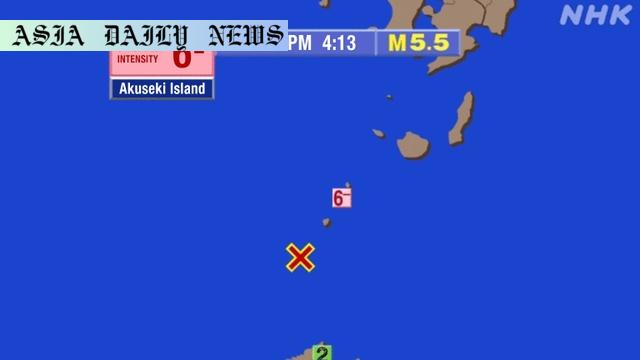Earthquake: A magnitude 5.5 quake struck Kagoshima Prefecture in southwestern Japan, registering as lower 6 on Japan’s seismic intensity scale.
A magnitude 5.5 earthquake struck Kagoshima Prefecture in southwestern Japan.
The quake registered as a lower 6 on the Japanese seismic intensity scale.
Authorities confirmed no tsunami threat following the earthquake.

Magnitude 5.5 Earthquake Hits Kagoshima Prefecture
On Thursday afternoon at 4:13 p.m., a magnitude 5.5 earthquake shook Kagoshima Prefecture in southwestern Japan, according to the Japan Meteorological Agency (JMA). The quake, classified as a lower 6 on Japan’s seismic intensity scale (ranging from 0 to 7), caused strong tremors in the area. This quake, although significant in magnitude, did not result in a tsunami, as confirmed by the JMA. Residents reported feeling intense shaking, with some experiencing difficulty in standing or moving during the event.
Japan is no stranger to earthquakes due to its position along the Pacific Ring of Fire, an area known for intense seismic activity. The Japanese seismic intensity scale provides critical data for understanding the severity of earthquakes and their localized impact. A lower 6 on the scale reflects strong shaking that may displace objects indoors, crack walls, or even damage less-reinforced structures. However, given Japan’s rigorous building codes designed to withstand such tremors, initial reports suggest limited infrastructural damage.
The swift dissemination of information and lack of a tsunami warning highlight Japan’s robust disaster preparedness measures. Earthquakes of this magnitude can result in widespread fear, yet the immediate assessment of the situation likely provided residents with a sense of reassurance amid uncertainty. Ongoing monitoring and analysis by the JMA and local authorities continue to track any aftershocks or additional risks in the affected region.
Understanding the Impact and Preparedness
The seismic activity in Kagoshima Prefecture underscores the critical importance of earthquake preparedness. Japan’s extensive early warning systems and public awareness campaigns play a vital role in reducing casualties and damages. Citizens are advised to secure heavy furniture, ensure emergency kits are accessible, and familiarize themselves with evacuation routes. Additionally, earthquake drills held regularly in schools, offices, and communities have been instrumental in fostering a culture of readiness.
The absence of a tsunami warning was a significant relief for residents, as coastal areas are particularly vulnerable to such secondary disasters. Historical data reveals that earthquakes in coastal regions often trigger tsunamis, sometimes causing far greater damage than the initial quake. The JMA’s prompt and clear communication about the lack of a tsunami threat likely minimized panic and allowed local officials to focus efforts on immediate safety checks and response measures.
This incident serves as a reminder of Japan’s resilient infrastructure and proactive disaster management systems. While the threat of earthquakes cannot be eliminated, the nation’s preparedness ensures that its people are better equipped to handle such events, reducing potential loss of life and property damage.
Looking Ahead: Strengthening Resilience
In the aftermath of the earthquake, attention is inevitably directed toward further enhancing Japan’s seismic resilience. Research into seismic activity, advanced technologies for detecting and predicting earthquakes, and continued public education remain critical priorities. The advancements in Japan’s structural engineering have rendered buildings capable of withstanding significant tremors, but evolving technologies may provide even greater safety measures in the future.
Moreover, the global community can learn from Japan’s experience and infrastructure planning. For countries located within seismic zones, studying Japan’s approaches to mitigation, response, and recovery can offer valuable insights. As climate change and other factors potentially exacerbate natural disasters like earthquakes, international cooperation and knowledge-sharing will be essential in ensuring global resilience.
Ultimately, Kagoshima’s experience highlights both the unpredictability of natural disasters and the vital role that preparation plays. As scientists, architects, emergency responders, and governments work together, the lessons learned from such incidents will undoubtedly contribute to a safer and more prepared society.
Commentary
A Timely Reminder of Natural Forces
The magnitude 5.5 earthquake in Kagoshima Prefecture is a stark reminder of the immense natural forces that are at play on our planet. Living in harmony with such forces requires robust preparedness, awareness, and rapid response systems—qualities that Japan has demonstrated time and again. While this event caused significant shaking, the absence of a tsunami threat is a relief. It’s a testament to the advanced monitoring capabilities and communication infrastructure in place that authorities quickly assessed and disseminated vital information to reassure the public.
The Resilience of Japanese Communities
Japan’s ability to withstand and recover from seismic events is nothing short of impressive. Rooted in a culture of preparedness, its communities are equipped with the knowledge and tools necessary to navigate such crises. Earthquake drills, stringent building codes, and disaster management protocols form the backbone of a society that refuses to be overwhelmed by seismic activity. By fostering a proactive mindset, Japan ensures that its citizens feel empowered, even in the face of uncertainty.
Global Lessons in Mitigation
This earthquake also holds broader lessons for the international community. With the growing frequency and intensity of natural disasters worldwide, other nations can learn from Japan’s example. Whether it’s investing in technology to detect earthquakes earlier or creating community awareness programs, adopting a proactive approach can save countless lives and minimize destruction. Collaboration between countries on disaster management strategies should become a more prominent global priority as we strive to live in harmony with Earth’s natural rhythms.
Ultimately, events like these, while disruptive, remind us of the importance of preparation and adaptability. They challenge us to continually strengthen our defenses against nature’s unpredictability, enabling societies to thrive even amid adversity.


